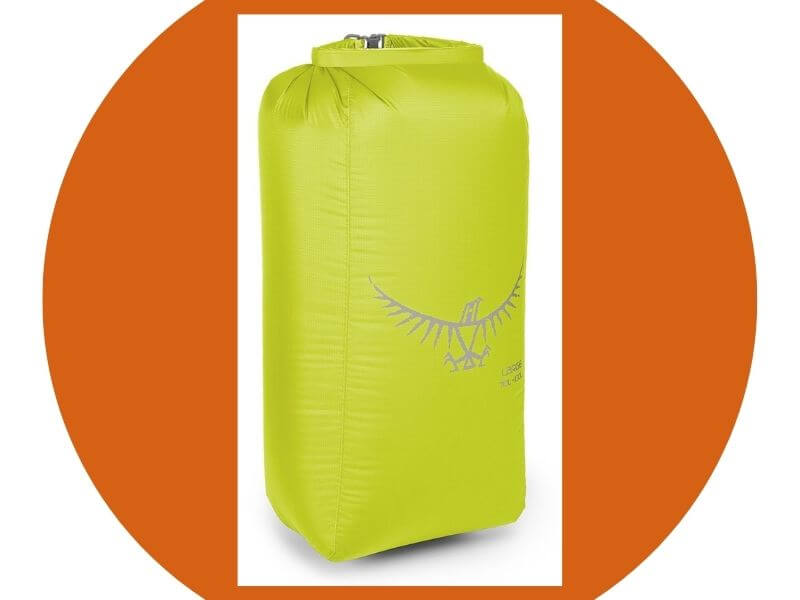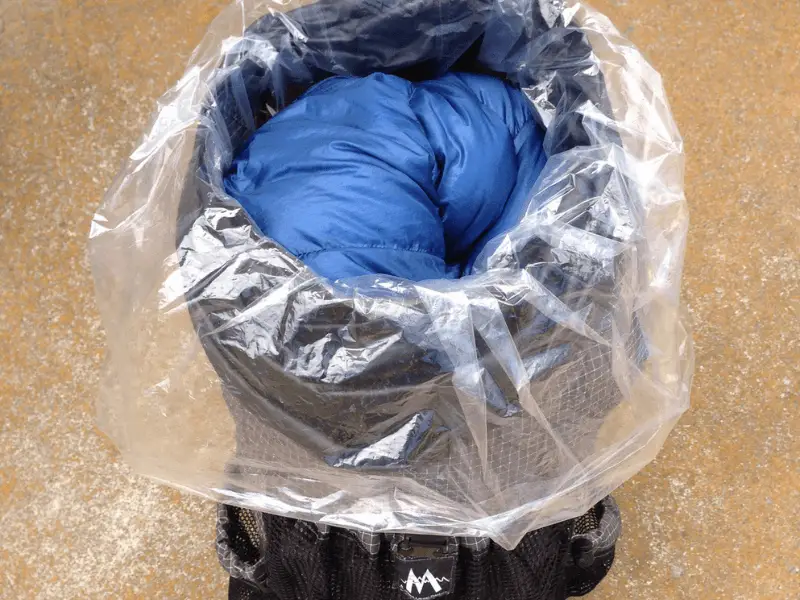Even the greatest backpack will not keep you dry for long in a strong storm. You should be able to keep the majority of your goods dry by using pack covers and liners. Is it really necessary to spend money on pricey pack liners when a simple compactor bag or rubbish bag suffices?
Pack liners have a large volume ratio and are least likely to wear and tear. They are therefore suitable for long hikes. On the other hand, garbage bags are relatively cheap and readily available. They are a great alternative to pack liners on shorter hikes.
Because a pack liner is usually utilized inside the pack, if an unexpected rain shower occurs throughout the day, you will most likely only need to worry about donning your rain gear and not maintaining the contents of your pack.

Can I use a garbage bag as a pack liner?
Yes, you can use a Garbage bag as a pack liner since it is waterproof and light. Garbage bags are lightweight, inexpensive, easily transportable, and can even serve as an emergency shelter.
Pack liner vs garbage bag – Key differences
Both a pack liner and a garbage bag have their pros and cons when it comes to waterproofing your gear. Since they have very small differences, picking either will come down to individual needs. Below is a table showing the key differences between a pack liner and a garbage bag.
| Pack liner | Garbage bag |
| It is highly durable, especially when you are going for long hikes. | Less durable, so it is only suitable for short hikes. |
| They have a large volume and, therefore, fit most backpacks. | Most come in 18-gallon sizes, so they are large enough for most backpacks. However, on some occasions, you may need to go bigger. |
| It is very expensive, going for about $40. | Very cheap. |
| Pack liners are heavier than most garbage bags. | They are quite light |
| Pack liners typically have roll-up covers and straps for simple water tightness. Roll them down and you’re done. | Garbage bags, on the other hand, can be folded or sealed with a rubber band, twist knot, or clothespin. An improperly folded trash bag’s top is more prone to becoming wet. |
| It is conceivable for a strong pack liner to be perforated, but this is quite unlikely. Although unsightly, the puncture can be mended with a small amount of duct tape. | Since they are cheap and easily available, there is no point in repairing them. Just get a new one. |
Garbage Bags
Garbage bags are the ultimate in lightweight, low-cost, waterproof adaptability and may be used in two ways: as a waterproof liner inside your backpack or as inside-the-stuff-sack protection for your clothes, sleeping bag, and other gear.
A large, heavy-duty trash bag, large enough to fit all of your goods and strong enough to withstand frequent usage and damage, is required for a pack liner.
Look for heavy-duty trash bags made for outdoor cleanup that are at least 3 mils thick. Contractor bags work well; the best ones are orange or similar bright colors, which increase visibility in a survival situation.
A heavy-duty trash bag can also function as an emergency shelter. A lighter-weight garbage bag is easier to work with and provides adequate protection from outside harm when lining a stuff sack.
When packing your sleeping bag or clothes, first place the trash bag’s bottom inside the stuff sack, then stuff your items into the trash bag and stuff sack at the same time. When you’re through, twist or otherwise tightly shut the trash bag’s opening.
Read more: Pack liner vs dry bags
Pack Liners
Although a waste bag can be used to cover the outside and inside of your pack, it is an inadequate substitute for a genuine pack liner.
Garbage bags flap wildly in the wind, are weak against brush and branches, and must be cut to allow shoulder straps to pass through.
Pack liners, on the other hand, are often composed of lightweight coated nylon or ultralight silnylon, with an elastic string that tightens around the pack to keep it in place. A cover shields the majority of your bag from the weather, as well as things, lashed to the outside.
See related: Silpoly vs Silnylon
However, pack liners do have flaws. They don’t, for example, completely cover the area around your shoulder straps and hip belts. The area above and around your shoulders is especially sensitive.
Water will frequently make its way in during a day’s rain. While pack coverings are far more robust than waste bags, they can still catch and rip on twigs and branches in densely forested areas.
Read more: Pack liner vs pack cover
When to use a pack liner
When embarking on a long hike, consider using a pack liner. They are less prone to tears, and if they do, duct tape can be used to fix them.
One of the features that distinguish and add value to a waterproof pack liner is its volume. It can hold whatever you have in your other stuff sacks and more. In an emergency, it is usually large enough to give refuge or basic clothing.
There is no way to compensate for it with other stuff sacks or equipment in your backpack because nothing else comes close to matching its versatility.
Recommended pack liner option
Here are two of the best pack liners in the industry:
Liner Bags for Nylofume Packs (51.9L)
The 0.91-ounce Nylofume Pack Liner Bags are little plastic bags that are extremely durable. They have a volume of 51.9 liters, which is plenty for most of the packs used on a regular basis, plus extra space for folding over the top to keep moisture from above out.
They are also odor-resistant and can be quickly repaired with packing tape, making them appropriate for use as food bag liners.

Clear Pack Liners by Gossamer Gear (48.5L)
Gossamer Gear makes extremely tough, transparent pack liners. They are lighter than trash compactor bags, weighing only 1.2 ounces, and are easier to repair if a hole is punched in one.
They are open at the top, so you must fold them over or twist-tie them to keep your items dry, but they work. They are also fairly priced. They inherit the inside color of your pack but have no effect on making your belongings easier to find.
When to use a garbage bag
Garbage bags are especially useful for trail-based activities like hiking in a rainy climate. They can be used as a rain cover for your backpack or as a waterproof pack liner (to keep your sleeping bag and clothing dry). As a result, they are perfect for shorter hikes.
However, a garbage bag is not an appropriate alternative for transporting your items when participating in water-based sports like canoeing or rafting.
Recommended garbage bag option
Hefty White Trash Compactor Bags (68L)
These thicker, 2,2-ounce plastic bags are harder to break than normal trash bags. They are inexpensive, easy to fix with tape, and lightweight. The durability is adequate, and you will only need one or two replacements per year.
Despite their massive size, they have numerous applications. On a cold night, for example, you could use a trash compactor bag as a makeshift bivy bag, which is only possible because they are big enough to fit my legs and quilt. Because they are white, they make it easier to find items in a dark backpack.
Bottom Line
The pack liner is great if you plan on going on long hikes and are looking for durability and volume. However, since the garbage bag is very cheap and easily available, it is best for shorter hikes and when you have a small gear volume.
Sources
https://youtu.be/eyA1ZAFTu9E
https://youtu.be/Kq9MSPdkDc8
